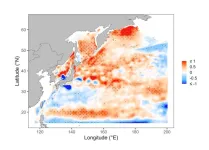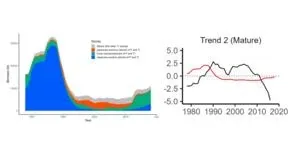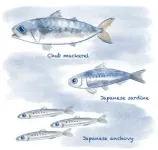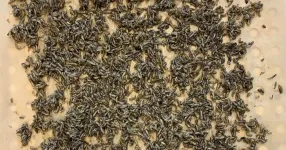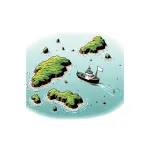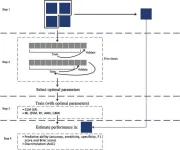(Press-News.org) Fish weight in the western North Pacific Ocean dipped in the 2010s due to warmer water limiting food supplies, according to a new study at the University of Tokyo. Researchers analyzed the individual weight and overall biomass of 13 species of fish. In the 1980s and 2010s, the fish were lighter. They attributed the first period of weight loss to greater numbers of Japanese sardine, which increased competition with other species for food. During the 2010s, while the number of Japanese sardine and chub mackerel moderately increased, the effect of climate change warming the ocean appears to have resulted in more competition for food, as cooler, nutrient-dense water could not easily rise to the surface. These results have implications for fisheries and policymakers trying to manage ocean resources under future climate change scenarios.
Whether it’s sushi, takoyaki (traditional octopus pancake balls) or grilled mackerel, seafood is an iconic and important part of Japanese cuisine. Japan’s seafood self-sufficiency has, however, been gradually declining for several decades. Local fisheries face multiple challenges from reduced sales and lower prices, labor shortages, changing consumer preferences and soaring costs. But perhaps one of the biggest threats comes from global warming.
Japan’s eastern coast is bordered by the western North Pacific Ocean, a highly productive marine area. According to the U.N. Food and Agriculture Organization, in 2019, the western North Pacific accounted for almost a quarter of the global total of fish caught and sold. However, results of new research at the University of Tokyo show that during the 1980s and 2010s, fish weight in the region changed dramatically.
“We investigated 17 fish stocks — that is, populations or groups of fish — from 13 species and found that many decreased in weight during this period” explained Professor Shin-ichi Ito from the Atmosphere and Ocean Research Institute at the University of Tokyo.
Ito, along with co-author Lin Zhen, a PhD student, analyzed fish weight and biomass data from Japan’s Fisheries Agency and the Japan Fisheries Research and Education Agency. Fish weight refers to individual fish (for example, a 200-gram mackerel), whereas biomass is the total weight of a species or group in an area (for example, 50,000 tons of mackerel).
The pair looked at long-term data for six fish populations from four species between 1978 and 2018, and at medium-term data for 17 fish populations from 13 species from 1995/1997 to 2018. Seawater temperature data between 1982 and 2014 were also studied to see if changes in the ocean’s surface and subsurface layers may have had an impact.
The results showed two periods of reduced fish body weight, first in the 1980s and again in the 2010s. The team attributed the 1980s weight decline to an increase in Japanese sardine, which likely led to greater competition for food within and between fish species. By comparison, in the 2010s, although there was a moderate increase in the population of Japanese sardine and chub mackerel, the team’s analysis appeared to show that reduced nutrient supply to the ocean’s surface from subsurface layers, due to global warming’s effect on the ocean, was an influential factor.
“With higher temperatures, the ocean’s upper layer becomes more stratified, and previous research has shown that larger plankton are replaced with smaller plankton and less nutritious gelatinous species, such as jellyfish,” explained Ito. “Climate change can alter the timing and length of phytoplankton blooms (explosive growth of microscopic algae at the ocean’s surface), which may no longer align with key periods of the fish life cycle. The migration of fish has also been shown to be affected, in other studies, which in turn impacts fish interaction and competition for resources.”
Ito hopes that fishery managers and policymakers will use research like this to better understand the changes taking place in the oceans around Japan to help make informed choices for the future. “Fish stocks should be managed differently than they were before, considering the increasing impact of climate-induced conditions. The situation fish experience is much more severe than decades ago,” he said. “If we cannot stop global warming, the quality of fish may decline. So, we need to take action so that we can enjoy a healthy ocean and delicious fish.”
####
Paper Title:
Lin Zhen and Shin-ichi Ito. Fish weight reduction in response to intra- and interspecies competition under climate change. Fish and Fisheries. DOI: 10.1111/faf.12818
Funding:
This study was conducted as an activity of the Joint PICES/ICES Working Group on the Impact of Warming on Growth Rates and Fishery Yields (GRAFY). This study was supported by The Japan Society for the Promotion of Science (JSPS) KAKENHI grant numbers JP21H04735 and JP22H05030.
Useful Links
Atmosphere and Ocean Research Institute (AORI): https://www.aori.u-tokyo.ac.jp/english/
Research Contact:
Professor Shin-ichi Ito
Atmosphere and Ocean Research Institute, The University of Tokyo
Kashiwanoha 5-1-5, Kashiwa, Chiba 277-8564, Japan
Email: goito@aori.u-tokyo.ac.jp
Tel.: +81-4-7136-6240
Press contact:
Mrs. Nicola Burghall
Public Relations Group, The University of Tokyo,
7-3-1 Hongo, Bunkyo-ku, Tokyo 113-8654, Japan
press-releases.adm@gs.mail.u-tokyo.ac.jp
About the University of Tokyo
The University of Tokyo is Japan's leading university and one of the world's top research universities. The vast research output of some 6,000 researchers is published in the world's top journals across the arts and sciences. Our vibrant student body of around 15,000 undergraduate and 15,000 graduate students includes over 4,000 international students. Find out more at www.u-tokyo.ac.jp/en/ or follow us on X (formally Twitter) at @UTokyo_News_en.
END
Climate change shrinking fish
Global warming increased competition for food in the 2010s, leading to decreased fish weight in important fishing area
2024-02-28
ELSE PRESS RELEASES FROM THIS DATE:
Yeast and kelp flies can replace fishmeal in feed
2024-02-28
Kelp flies and marine yeast cultivated on by-products from the seafood industry can be used in feed for farmed salmon. Replacing fishmeal and soybeans can create more sustainable and circular food production, according to a thesis from the University of Gothenburg.
Food from aquaculture, such as farmed fish, is the food industry’s fastest growing sector. One key reason is that this is a nutritious and protein-rich food that is generally more sustainably produced than protein from land animals.
However, fish farming also has challenges. One is obtaining sufficient amounts of sustainable high-quality feed. Currently, fish feed accounts for about ...
Meltwater in the North Atlantic can lead to European summer heatwaves, study finds
2024-02-28
Scientists from the National Oceanography Centre (NOC) have discovered that increased meltwater in the North Atlantic can trigger a chain of events leading to hotter and drier European summers.
The paper, which will be published in the European Geosciences Union’s open access journal Weather and Climate Dynamics, suggests that European summer weather is predictable months to years in advance, due to higher levels of freshwater in the North Atlantic.
Discussing the implications, lead author Marilena Oltmanns, Research Scientist at the National Oceanography Centre, said: “While the UK and northern Europe experienced unusually cool and wet weather in Summer 2023, Greenland experienced ...
A threat to what is ours: How Japanese people react to perceived territorial infringements
2024-02-28
Osaka, Japan – Throughout the world, it is common for threats to national sovereignty or territorial integrity to stir up strong emotions among the public. Now, researchers from Japan have found that the strength of the reaction to such threats can break down along political lines in interesting ways.
In a study published in Peace and Conflict: Journal of Peace Psychology, researchers from Osaka University have revealed that the Japanese public is highly sensitive to what are known as “collective ownership ...
Experiment captures why pottery forms are culturally distinct
2024-02-28
Potters of different cultural backgrounds learn new types differently, producing cultural differences even in the absence of differential cultural evolution. The Kobe University-led research has implications for how we evaluate the difference of archaeological artifacts across cultures.
Cultural artifacts differ between cultures but are relatively stable within cultures. This makes pottery, and in particular its form, an important archaeological indicator to determine the presence of different cultural groups in specific locations and how they influenced each other over time. But where do such culturally stable variations arise from? The typical explanation for this is through “selective ...
A liking for licking
2024-02-28
HONG KONG (28 Feb 2024) — Unique insights into the social lives of cattle revealed in a new study by scientists at City University of Hong Kong (CityUHK) can enhance our understanding of animal behaviour and welfare. The study suggests that sex and social status influence social grooming (where one animal licks another, also known as allogrooming) among free-ranging feral cattle in Hong Kong.
The CityUHK researchers found that feral cattle performed preferential grooming of certain individuals and, in particular, that more dominant females received more grooming. This asymmetrical distribution of licking also applied to whom male cattle decided to ...
Scientists provide first detailed estimates of how much sediment is supplied to coral islands from the reef system
2024-02-28
Scientists have produced the first detailed estimates of how much sediment is transported onto the shores of coral reef islands, and how that might enable them to withstand the future threats posed by climate change.
Coral reef islands are low-lying accumulations of sand and gravel-sized sediment deposited on coral reef surfaces.
The sediments are derived from the broken down remains of corals and other organisms that grow on the surrounding reef. Therefore, the rate of supply of sediment from reefs is a critical control on island formation and future change.
The international team of researchers used data available for 28 reef islands in the Indian and Pacific Oceans, widely ...
Study details five cutting-edge advances in biomedical engineering and their applications in medicine
2024-02-28
Bridging precision engineering and precision medicine to create personalized physiology avatars. Pursuing on-demand tissue and organ engineering for human health. Revolutionizing neuroscience by using AI to engineer advanced brain interface systems. Engineering the immune system for health and wellness. Designing and engineering genomes for organism repurposing and genomic perturbations.
These are the five research areas where the field of biomedical engineering has the potential to achieve tremendous impact on the field of medicine, according to “Grand Challenges at the Interface of Engineering and Medicine,” a study published by a 50-person task force published ...
Traditional regression approach outperformed machine learning algorithms in predicting optimal surgical method in patients with submucosal tumors.
2024-02-28
Submucosal tumors (SMTs) are usually found in the stomach and esophagus during an upper endoscopy. Submucosal tunneling endoscopic resection (STER) and non-tunneling endoscopic resection (NTER) are the two most commonly used techniques in the treatment of gastric and esophageal SMTs. As novel technologies continue to shape the medical landscape, machine learning (ML) algorithms find increased application, demonstrating enhanced performance in various fields. Although some studies have evaluated the incremental value of flexible ML methods, comparisons with traditional logistic regression (LR) models are lacking.
To this end, a recent study by a team of researchers from China published in the ...
A survey on federated learning: A perspective from multi-party computation
2024-02-28
Federated learning (FL) has emerged as a popular machine learning paradigm which allows multiple data owners to train models collaboratively with out sharing their raw datasets. It holds potential for a wide spectrum of nalytics applications on sensitive data. For example, federated learning has been applied on medical big data analysis such as disease prediction and diagnosis without revealing the patients’ private medical information to thirdparty services. It has also been exploited by banks and insurance ...
New pediatric cancer marker, new hope for a treatment target
2024-02-28
Researchers have newly identified a universal, essential biomarker for the childhood cancer neuroblastoma – and a potential new target for treatment.
Neuroblastoma accounts for 15% of all pediatric cancer deaths and is the most common source of childhood tumors outside of brain cancer. The disease develops in early nerve tissue, usually in and around the adrenal glands, and typically affects children under age five. High-risk cases have a five-year survival rate of just 50%.
Led by UC San Francisco, researchers suspected the oncoprotein AF1q, which is known to play a role in leukemia and solid tumor progression, might be important in tumors of neural origin ...
LAST 30 PRESS RELEASES:
Orthopedics can play critical role in identifying intimate partner violence
Worms as particle sweepers
Second spider-parasitic mite described in Brazil
January 2026 issues of APA journals feature new research on autism, pediatric anxiety, psychedelic therapy, suicide prevention and more
Private equity acquired more than 500 autism centers over the past decade, new study shows
New cervical cancer screening guidelines from the US Department of Health and Human Services
Estimated burden of COVID-19 illnesses, medical visits, hospitalizations, and deaths in the US from October 2022 to September 2024
Smartphone use during school hours by US youth
Food insecurity and adverse social conditions tied to increased risk of long COVID in children
Earliest, hottest galaxy cluster gas on record could change our cosmological models
Greenland’s Prudhoe Dome ice cap was completely gone only 7,000 years ago, first GreenDrill study finds
Scientific validity of blue zones longevity research confirmed
Injectable breast ‘implant’ offers alternative to traditional surgeries
Neuroscientists devise formulas to measure multilingualism
New prostate cancer trial seeks to reduce toxicity without sacrificing efficacy
Geometry shapes life
A CRISPR screen reveals many previously unrecognized genes required for brain development and a new neurodevelopmental disorder
Hot flush treatment has anti-breast cancer activity, study finds
Securing AI systems against growing cybersecurity threats
Longest observation of an active solar region
Why nail-biting, procrastination and other self-sabotaging behaviors are rooted in survival instincts
Regional variations in mechanical properties of porcine leptomeninges
Artificial empathy in therapy and healthcare: advancements in interpersonal interaction technologies
Why some brains switch gears more efficiently than others
UVA’s Jundong Li wins ICDM’S 2025 Tao Li Award for data mining, machine learning
UVA’s low-power, high-performance computer power player Mircea Stan earns National Academy of Inventors fellowship
Not playing by the rules: USU researcher explores filamentous algae dynamics in rivers
Do our body clocks influence our risk of dementia?
Anthropologists offer new evidence of bipedalism in long-debated fossil discovery
Safer receipt paper from wood
[Press-News.org] Climate change shrinking fishGlobal warming increased competition for food in the 2010s, leading to decreased fish weight in important fishing area
